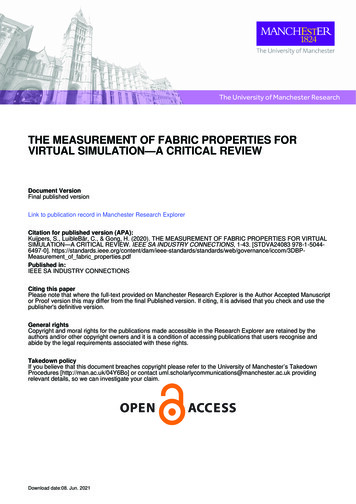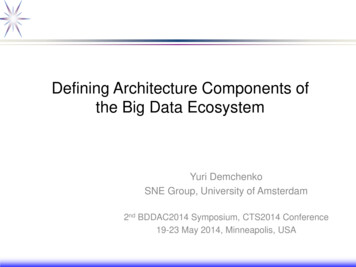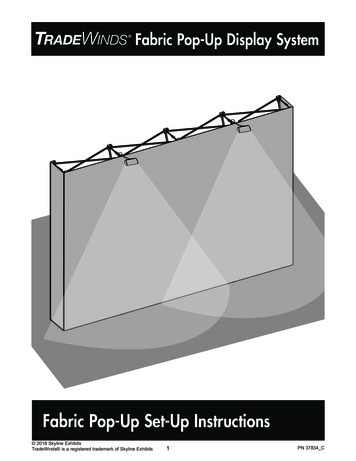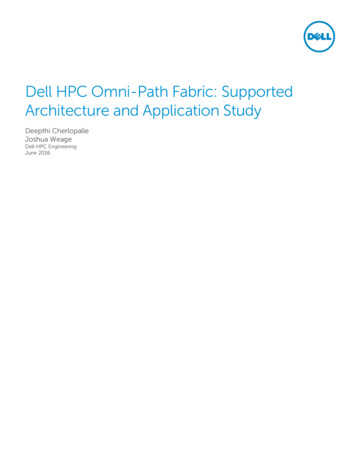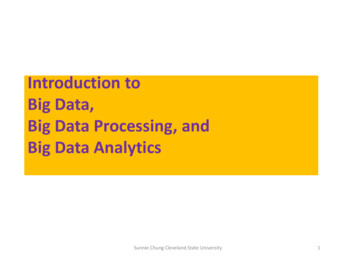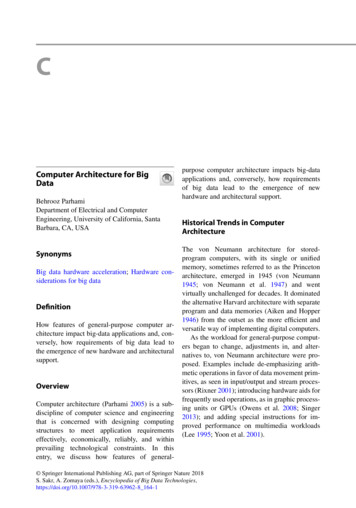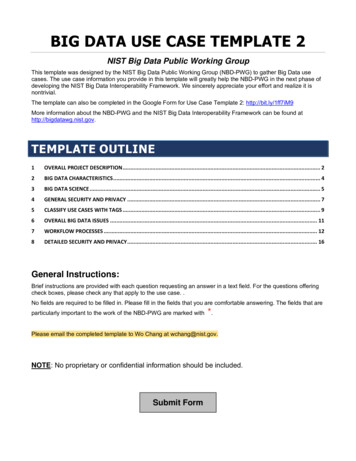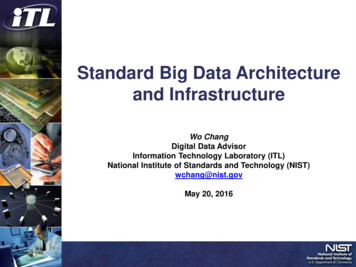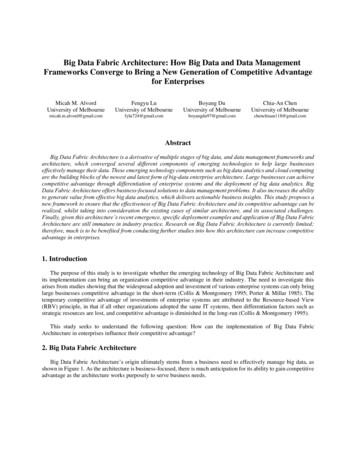
Transcription
Big Data Fabric Architecture: How Big Data and Data ManagementFrameworks Converge to Bring a New Generation of Competitive Advantagefor EnterprisesMicah M. AlvordUniversity of MelbourneFengyu LuUniversity of MelbourneBoyang DuUniversity of MelbourneChia-An ChenUniversity of tBig Data Fabric Architecture is a derivative of multiple stages of big data, and data management frameworks andarchitecture, which converged several different components of emerging technologies to help large businesseseffectively manage their data. These emerging technology components such as big data analytics and cloud computingare the building blocks of the newest and latest form of big-data enterprise architecture. Large businesses can achievecompetitive advantage through differentiation of enterprise systems and the deployment of big data analytics. BigData Fabric Architecture offers business-focused solutions to data management problems. It also increases the abilityto generate value from effective big data analytics, which delivers actionable business insights. This study proposes anew framework to ensure that the effectiveness of Big Data Fabric Architecture and its competitive advantage can berealized, whilst taking into consideration the existing cases of similar architecture, and its associated challenges.Finally, given this architecture’s recent emergence, specific deployment examples and application of Big Data FabricArchitecture are still immature in industry practice. Research on Big Data Fabric Architecture is currently limited;therefore, much is to be benefited from conducting further studies into how this architecture can increase competitiveadvantage in enterprises.1. IntroductionThe purpose of this study is to investigate whether the emerging technology of Big Data Fabric Architecture andits implementation can bring an organization competitive advantage in their industry. The need to investigate thisarises from studies showing that the widespread adoption and investment of various enterprise systems can only bringlarge businesses competitive advantage in the short-term (Collis & Montgomery 1995; Porter & Millar 1985). Thetemporary competitive advantage of investments of enterprise systems are attributed to the Resource-based View(RBV) principle, in that if all other organizations adopted the same IT systems, then differentiation factors such asstrategic resources are lost, and competitive advantage is diminished in the long-run (Collis & Montgomery 1995).This study seeks to understand the following question: How can the implementation of Big Data FabricArchitecture in enterprises influence their competitive advantage?2. Big Data Fabric ArchitectureBig Data Fabric Architecture’s origin ultimately stems from a business need to effectively manage big data, asshown in Figure 1. As the architecture is business-focused, there is much anticipation for its ability to gain competitiveadvantage as the architecture works purposely to serve business needs.
Figure 1. Building Blocks of Big Data Fabric Architecture. Data Management Issues from McDaniel (2019),Data Fabric from Raza (2018), Data Fabric Architecture from Morrell (2017), Big Data Fabric Architecture fromYuhanna, Leganza, Warrier, and Izzi (2016).2.1. Elusive Benefits of Big Data Fabric ArchitectureBig Data Fabric Architecture was proposed to not only manage data, but to generate extractable, useful informationfrom the data and turn it into actionable business insights, without the complication of multi-platform sources andintegration issues that are prevalent with current enterprise architecture trends (Yuhanna et al. 2016; Yuhanna & Istok2017). As shown in Figure 2, Big Data Fabric Architecture rests on the foundation of the following emergingtechnologies that have been respectively known to generate their own respective forms of competitive advantage: BigData Analytics, Cloud Computing, and Data Fabric Architecture.
Figure 2. Elements that comprise Big Data Fabric Architecture to generate new competitive advantage.2.2. Big Data FabricBig Data Fabric is a compound word coined by Yuhanna et al. (2016) and combines technical elements from ‘BigData’ and ‘Data Fabric’. The difference is that Data Fabric does not guarantee big data in its data managementframework. The convergence of these two existing technologies creates the foundation from which the term Big DataFabric is built. The formal definition of Big Data Fabric is “bringing together disparate big data sources automatically,intelligently, and securely and processing them in a big data platform technology, using data lakes, Hadoop 1, andApache Spark 2 to deliver a unified, trusted, and comprehensive view of customer and business data” (Dooley 2018;Yuhanna & Istok 2017).12Apache Hadoop is a registered trademark of the Apache Software Foundation.Apache Spark is a registered trademark of the Apache Software Foundation.
2.3. Big Data Fabric Architecture LayersFigure 3. Big Data Fabric Architecture. From “Big Data Fabric Drives Innovation and Growth,” by N Yuhannaet al., 2016, Forrester Research. Copyright 2016 by Forrester Research.Big Data Fabric Architecture, as shown in Figure 3, is comprised of Big Data analytical tools and the following 5layers (Moxon 2018):1. Data Ingestion: Data is loaded into big data repositories.2. Data Management and Intelligence: How data is being governed, secured, managed, accessed, and otherrelated processes.3. Orchestration: Data is integrated and transformed into meaningful information that is consumable by theusers.4. Data Discovery: The available data that users can see.5. Data Access: An interface for users to access and get data to obtain business insights.2.3.1.Layer 1: Data IngestionData ingestion gathers data and brings it into the data processing systems. This layer processes incoming data,prioritizing sources, validating data, and routes it to the best location for storage after which the data is available foruse. Data extraction can happen in a single, large batch or broken into multiple smaller ones. The data ingestion layerwill choose the method based on the situation, prioritizing a faster loading time optimized for the program (John &Misra 2017).2.3.2.Layer 2: Data Management and IntelligenceData Management and Intelligence is interwoven across all other layers in the architecture to ensure consistencyand uniformity of data security, metadata management, data governance, compliance, internal policies, externalpolicies, and data quality across the entire data process, regardless of the data’s database or origins (Hassell 2018;Moxon 2018).
2.3.3.Layer 3: Data OrchestrationData orchestration is a relatively new concept to describe the set of technologies that provides an abstract for dataaccess across storage systems, virtualizes all the data, and presents the data via standardized APIs with a globalnamespace to data-driven applications (Bakshi 2011, p. 4; Diederich 2019).2.3.4.Layer 4: Data DiscoveryData discovery is the business user driven and iterative process of discovering patterns and outliers in data (BARCResearch 2017). Data discovery requires skills from business analysts in understanding data relationships and datamodeling, as well as in using data analysis and guided advanced analytics functions to reveal insights (BARC Research2017).2.3.5.Layer 5: Data AccessData Access is, in its basic form, code that web developers write to interact with the data source and is tailored tobusiness-specific implementations (Patton 2006). With this customized code, Data Access Layer retrieves andmodifies data from the databases by connecting to the database, open and close connections, and executive CRUD(Create, Read, Update, and Delete) operations (Kanjilal 2015).2.4. Big Data Analytics and Cloud ComputingBig Data Analytics is a process of collecting and managing data to allow for business analytics to generatemeaningful observations and insights, as shown in Figure 4.Figure 4. Understanding the structure and role of Big Data Analytics. From “Beyond the hype: Big dataconcepts, methods, and analytics,” by A Gandomi, & M Haider, 2015, International Journal of InformationManagement, 35, p. 141. Copyright 2015 by International Journal of Information Management.Big Data Analytics can only be made possible through the platform of cloud computing. As local hardware areincapable of processing data over one terabyte, such as big data, vendors such as Microsoft or Amazon offer a servicecalled Infrastructure as a Service (IaaS) where the infrastructure uses the computational power of cloud computing,instead of local hardware, to generate, collect, and store big data (Bakshi 2011; Schroeck, Shockley, Smart, RomeroMorales, & Tufano 2012).Big Data Fabric Architecture also allows for one unified platform (refer to Figure 3) that provides one interface toview the consolidated data from various cloud computing and local platforms and its associated databases. Thisculminates in establishing a more holistic single version of truth in the data they are producing (Pearlman 2019), thusgenerating a new form of competitive advantage not previously utilized.
2.5. Limitations with Data Fabric ArchitectureData Fabric Architecture is the predecessor of Big Data Fabric Architecture, however due to its limitations, it canbe deemed as an inferior option to gaining competitive advantage. Table 1 summarizes capabilities that Big DataFabric has compared to Data Fabric. As shown in Figure 5, Data Fabric Architecture does not contain big data-drivenvalue capabilities. Since Big Data Fabric is more capable of delivering higher value from extracted data to generateactionable business insights, large businesses should focus on achieving Big Data Fabric Architecture over itsavailable predecessor.Table 1.Differences with Big Data Fabric and Data Fabric.Big Data FabricData FabricAbility to handle various types of dataCan only handle structured dataReal-time AnalyticsMajority of data are batch-processedAbility to integrate different big data analytical tools(e.g. Hadoop and RDBMS, despite their differences, theinfrastructure can still integrate the two tools)If analytical tools cannot talk to each other, then toolscannot be integratedNote. Information for Big Data Fabric from Foote (2019) and Information for Data Fabric from Yuhanna andIstok (2017).Figure 5. Data Fabric Architecture. Adapted from Secrets to Utilizing a Data Fabric. Retrieved data-fabric/. Copyright 2018 by John Morrell.
3. Competitive Advantage and Enterprise SystemsStudies have shown that IT systems, data, and information are crucial elements that have been proven to increasean organization’s competitive advantage through the ability of achieving the five competitive forces as shown inFigure 6. Due to the rise of the big data revolution, collecting data and generating valuable information is one of thelatest principal business strategies to gain competitive advantage (Lohr 2016; Porter & Millar 1985). Therefore,adopting an enterprise architecture that can differentiate a large business from its competitors is paramount toachieving competitive advantage (Collis & Montgomery 1995).Figure 6. The five competitive forces that shape strategy and industry competition. From “The Five CompetitiveForces That Shape Strategy,’ by M. E. Porter, 2008, Harvard Business Review, 86, p. 80. Copyright 2008 by M. E.Porter.3.1. Past, Present, and Future Trends of Enterprise ArchitecturesEnterprise Systems such as an Enterprise Resource Planning (ERP) system or Customer Relationship Management(CRM) system have been a past trend that have proven results in generating competitive advantage through dataintegration, process differentiation, and data automation (Davenport, Thomas, Harris Jeanne, & Cantrell 2004; Turban& Volonino 2010, pp. 301-332).Currently, the trend is to switch to hybrid infrastructures where enterprises use both local and cloud-basedplatforms to achieve competitive advantage through increased efficiency, reduced IT expenses, and generating realtime data for analysis (Michael 2014, p. 579; Xiang, Schwartz, Gerdes & Uysal 2015, p. 121). However, becausehybrid platforms inevitably generate big data, enterprises are challenged with managing big data effectively, resultingin extensive data management issues (Zikopoulos & IBM 2011; Porter & Millar 1985, p. 7).Moreover, studies have shown that only 25% of data in enterprises are being used for analytics (Yuhanna & Istok2017). Whilst the current trend has been towards benefits from cloud-based platforms, the opportunity is currentlywide open for large businesses to zone into the vastly uncaptured and largely unutilized method of effectively
extracting value from big data, and turning them into actionable insights, thus gaining a new generation of competitiveadvantage.4. Case Analyses4.1. Organizations using Big Data Analytics to Gain Competitive AdvantageFrom a technical point of view, big data is different from traditional data resulting from transactions. Therefore, itrequires new data management and analysis tools. Research conducted by Ylijoki and Porras (2016) uses Google andAmazon as examples to suggest that companies who utilize data tend to heavily gain competitive advantage over theircompetitors that are less data driven. The volume, variety and velocity of big data can pose challenges for datamanagement technology and the key to gain valuable insights is to apply proper analytics tools to the big data (Ylijoki& Porras 2016).Netflix, as a top online streaming service provider, has utilized big data analytics since 2006. The primary objectivefor Netflix is to provide users with a better recommendation system using big data analytics (Maddodi & K 2019).The recommendation system able to achieve a high level of accuracy based on user preference through two separatedata collection systems:1. Content-based filtering collects previous watching history of the subscriber, and2. Collaborative filtering based on similar user profiles.Netflix was able to build a hybrid recommendation system that combined both content-based filtering andcollaborative filtering. The company also adapts Amazon web service cloud computing platform to help it discovercustomer insight and manage customer’s data. The scalability and agility offered by cloud computing ensure Netflixsuccessfully provides content to millions of customers around the globe.4.2. Organizations Using Data Fabric to Gain Competitive AdvantageThe implementation of data fabric allows organizations to speed up the digital transformation and the key toinnovation is powered by advanced enterprise architecture. Data-driven organizations have a natural competitive edgewhen it comes to sensing the markets, responding to customers, anticipating cyberthreats, and optimizing theirprocesses (Baer 2018). Service providers such as NetApp and Winshuttle deploy data fabric architectures toenterprises in aid to help the organization to process, manage, analyze and store data from a multitude of sources.Dominos, a globally known pizza company, have conducted digital transformation through the adaption of DataFabric Architecture (Talend 2020). The goal for Dominos is to integrate data from every channel and to generate asingle view of its operation. With data fabric, Dominos is able to build a data collection system that tracks from allthe point of sale systems, supply chain centres and through all other advertising channels. Ducati is another companythat utilises Data Fabric Architecture to achieve competitive advantage in the motorcycle industry (NetApp 2020).Ducati meticulously produced only 55,000 motorcycles in 2018. Compared with industry competitors that haveproduction capacity in the millions, Ducati visioned itself to gain competitive advantage through a fast innovationcapability. Therefore, the company treats data as a crucial part in terms of accelerating its success. By moving the datato a hybrid cloud platform, Ducati able to collect and analyse that data from more than 15,000 motorcycles across theworld, which greatly boosts its information transformation speed from the road to product innovation. The capabilitiesof data fabric are the main reason that allow enterprises to gain competitive advantage. Some of key capabilities are:1. Digital Asset ManagementData fabric simplifies the process of storing, processing and managing different forms of data. It also fosters thecompliance and correct usage of digital assets. Moreover, the speed to organize and locate digital assets can besignificantly improved, while the redundant storage and financial cost can be reduced.2.Dynamic data model
This capability offers enterprises with flexible and extensible data models. It allows organizations to access andmanipulate information without affecting the core data. In relation to new opportunities and competitions, dynamicdata models can also flexibly evolve with changes in business requirements.5. Remaining Challenges5.1. Challenge 1: Management Decision-making and ActionMany organizations do not realize that the analytical capabilities enabled by big data fabric are not directly relatedto business benefits alone. It is through the conjunction of organizational processes and human decision-making thatvalue can be attained by using a data-centric architecture (Shanks & Sharma 2011). Therefore, to fully realize thebenefits from big data fabric, business management should play key roles in value-creation and decision-makingprocesses, to understand the insights generated from big data analytics, identify potential opportunities, orchestrateresources and turn these insights into actions to help their organizations achieve key business objectives (Shanks &Sharma 2011).5.2. Challenge 2: Data IntegritySince data is one of the most important assets for enterprises, it is essential for organizations to maintain the qualityof data. Repercussions of bad data will waste time, increase expenses, decrease productivity, and weaken decisionmaking (Nagle, Redman & Sammon 2017). There is still a challenge for large businesses to assure data integrity whileimplementing big data fabric, as a large portion of the enormous amount of big data might be outdated, incorrect,duplicated and incomplete (Barton 2019). Currently, only 3% of the organizations meet data quality standards (Nagle,Redman & Sammon 2017).5.3. Challenge 3: Continuous Good Data Management PracticeWhile data fabric architecture provides a solution for data management, the increasing proliferation of data andthe lack of good data management practices is a critical challenge for many large businesses. Data management is agroup of practices that consists of the planning, development, implementation and administration of a system that usesdata in a secure and efficient way (Office of the Deputy Prime Minister 2020). Research conducted by Vidgen, Shawand Grant (2017) shows that managing data quality, security and privacy is still a major issue to enterprises. Thechallenge still remains to ensure improvements in developing strategies and policies relating to data security, decisionmaking processes, data governance, and data management practices (Rifaie, Alhajj, & Ridley 2009).6. A Proposed Framework for Generating Competitive Advantage with Big Data FabricArchitectureThe challenges make it apparent that a new generation of competitive advantage from Big Data Fabric Architectureis reliant upon the effectiveness of value being driven from big data, by being able to extract data accurately and turnthem into actionable business insights (Riahi & Riahi 2018).Therefore, to ensure that competitive advantage is gained through the adoption of Big Data Fabric Architecture,this paper proposes a framework that incorporates four principles regarding maximizing value from big data analysis(Begoli & Horey 2012), and three principles regarding effective big data governance (Malik 2013). This proposedframework and its composed elements work interconnectedly to capture critical objectives in a business. The proposedframework also helps to achieve value driven by big data, thus providing a framework by which competitive advantagecan be achieved through Big Data Fabric Architecture.
6.1.1.Support a Variety of Analysis Methods.In order to generate value from data in a large business, during the process of knowledge discovery, organizationsshould apply a wide range of different tools and analysis methods (Begoli & Horey 2012). This will employ a varietyof techniques and tools to collect big data, such as statistical analysis, data mining and machine learning, datavisualization, and visual analysis (Begoli & Horey 2012). Having a large business employ a variety of analysismethods will bring a more comprehensive understanding of their data and thus be able to generate greater actionableinsights.6.1.2.One Size Does Not Fit AllCase studies have shown that a single style database such as a large relational database cannot meet all of therequirements from different types of analysis methods and structures of big data (Begoli & Horey 2012). Therefore,in order to gain value from data and turn these into actionable insights, a specialized data management system shouldbe deployed. This will help large businesses effectively store, organize and manage vast stores of various types of bigdata, and to perform different types of analysis (Mousanif et al. 2014).6.1.3.Data Security ManagementThe storing, access and processing of vast amounts of data enabled by big data fabric can bring potential securityand privacy threats for organizations (Dooley 2018). Therefore, organizations should establish a common securitystandard based on the relevant regulations and privacy policies across the entire big data fabric, systems and platforms.This will make sure data is securely collected, stored and transmitted to protect data security and meet compliancerequirements (McSweeney 2019). It is also necessary to establish an access control, which only allows authorizedpeople to access big data, and update data with a proper audit trail (McSweeney 2019).6.1.4.Make Data AccessibleAccessible data for business users is critical in achieving goals. Therefore, it is imperative to make data effectivelyaccessible by users to ensure highly summarized data and turn into actionable insights (Begoli & Horey 2012).Disparate systems should communicate with a standard protocol to quickly present the results to users and have aflexible method to enable users to interact with data systems, such as using web-enabled APIs to visualize analyticsresults (Begoli & Horey 2012).6.1.5.Engage organization, processes and peopleSince Big Data Fabric Architecture enables data exchange in multiple cloud platforms and disparate systemsacross the whole enterprise, the successful implementation of Big Data Fabric Architecture requires the engagementof the three main elements: people, processes, and organization (Malik 2013). To gain competitive advantages byimplementing big data fabric, it is essential to understand the enterprise’s business strategies and business processes.To fully realize the benefits from big data fabric, the organizations might need to re-engineer business processesto extract business values from unstructured and semi-structured data as traditional business processes only fit thestructured data (Jha, Jha & O’Brien 2016). By redesigning the core business processes, organizations can gainthorough insights of their operations and quickly make responses while facing dramatic changes (Jha, Jha & O’Brien2016). In this way, the design of Big Data Fabric Architecture can align with the organization’s business strategies,objectives and needs, to achieve business-IT alignment and help organizations generate valuable insights to supportbetter decision-making (Luftman 2000).Moreover, organizations and people should be on the same page to construct a comprehensive big data fabric(Ansyori, Qodarsih, & Soewito 2018). Therefore, it is necessary to have training for the management and employeesto take full advantage of big data fabric, which includes detailed knowledge of big data fabric, relevant guidelines,procedures and requirements for use. Besides this, and to ease organizational transition, it should also involve changemanagement to help employees understand and accept the new big data fabric (Dilnutt 2005).
6.1.6.Set clear policies and standardsThe Big Data Fabric Architecture enables organizations to deal with a vast amount of data from both inside andoutside of the enterprise. With extremely high volume of data generation and exchange, it should involve the keystakeholders from the whole enterprise, and establish a set of common standards and policies to ensurecompatibility, integrity and integration of data across multiple applications, systems and platforms (Boh & Yellin2006). Also, the interactions between the different layers of Big Data Fabric Architecture should be standardized toenable continuous monitoring and a proven track of its performance (McSweeney 2019).The organization can establish the standards and policies by considering three principles: modify and update thepolicies in an agile manner, transparent constructing process, and implement suitable existing criteria (Larno,Seppänen, & Nurmi 2019). With thorough standards and policies, the Big Data Fabric Architecture can help theorganization effectively process the big data in good order, and eliminate the potential risks and errors to the maximumextent.6.1.7.Follow the best industry practicesSince big data fabric is an emerging technology, the organization might face multiple practical implementationchallenges. To successfully implement a Big Data Fabric Architecture, organizations need to follow the best practiceswhich are commonly accepted by the industry, and has proven to lead to an implementation success (Malik 2013;Abunadi 2019). By following best practices, organizations can address underlying technical difficulties. This canminimize the potential risks, such as the existence of conflicting frameworks and business needs, to ensure thesuccessful implementation of the project (Abunadi 2019). It can also help organizations to effectively direct theirefforts to achieve their strategic goals, and make sure that the design of big data fabric has a comprehensive coverageof the whole enterprise. The organization can set its practice, such as integrating the business process, in order toenhance information interoperability, and using the cloud for information sharing across different units to strengthencollaboration, as well as using technological competencies to optimize the utilization of the organizational resources(Abunadi 2019).6.2. Proposed FrameworkThe proposed framework to ensure competitive advantage is achieved through Big Data Fabric Architecture isshown in Figure 7.
Figure 7. Proposed framework to achieving competitive advantage through big data fabric architecture.
7. ConclusionThis paper has found that Big Data Fabric Architecture is advantageous in its technical underpinnings, but it isthrough the combination with non-technical factors, such as continuous good data management and clear datastrategies, that serve to be the keys to success in achieving competitive advantage. Moreover, competitive advantageis most effective when enterprises turn data-generated insights and observations into actionable decision-making. Withthese findings, this paper has proposed a framework, as shown in Figure 7, which consists of elements that worktogether to ensure that competitive advantage is achieved through Big Data Fabric Architecture for enterprises.8. ReferencesAbunadi, I 2019, ‘Enterprise Architecture Best Practices in Large Corporations’, Information, vol. 10, no. 10, p.293.Ansyori, R, Qodarsih, N & Soewito, B, 2018, ‘A systematic literature review: Critical Success Factors toImplement Enterprise Architecture’, Procedia Computer Science, vol. 135, pp. 43-51.Baer, T 2018, The Modern Data Fabric – What It Means to Your Business, viewed 22 May df.Begoli, E & Horey, J 2012, Design Principles for Effective Knowledge Discovery from Big Data. Paperpresented at the 2012 Joint Working IEEE/IFIP Conference on Software Architecture and European Conference onSoftware Architecture.Barton, N 2019, Guaranteeing Data Integrity in the Age of Big Data, viewed 22 May integrity-in-the-age-of-big-data/#.Boh, WF & Yellin, D 2006, ‘Using Enterprise Architecture Standards in Managing Information Technology’,Journal of Management Information Systems, vol. 23, no. 3, pp. 163-207.Bakshi, K 2011, Considerations for cloud data centers: Framework, architecture and adoption. Paper presentedat the 2011 Aerospace Conference.BARC Research 2017, Data Discovery: A Closer Look at One of 2017's Most Important BI Trends, viewed 22May 2020, https://bi-survey.com/data-discovery.Collis, DJ & Montgomery, C. A. 1995, ‘Competing on Resources: Strategy in the 1990s’, Harvard BusinessReview, vol. 73, no. 4, p. 118.Dooley, B 2018, Data Fabrics for Big Data, viewed 22 May 2020, brics-for-big-data.aspx.Dilnutt, R 2005, ‘Enterprise Content Management: Supporting Knowledge Management Capability’, TheInternational Journal of Knowledge, Culture, and Change Management: Annual Review, vol 5, pp. 73-84.Davenport Thomas, H., Harris Jeanne, G. & Cantrell, S 2004, ‘Enterprise systems and ongoing process change’,Business Process Management Journal, vol, 10, no. 1, pp. 16-26.Diederich, T 2019, Data Orchestration: What Is it, Why Is it Important?, viewed 22 May -its-open-so
Data Fabric from Raza (2018), Data Fabric Architecture from Morrell (2017), Big Data Fabric Architecture from Yuhanna, Leganza, Warrier, and Izzi (2016). 2.1. Elusive Benefits of Big Data Fabric Architecture Big Data Fabric Architecture was proposed to not only man
